
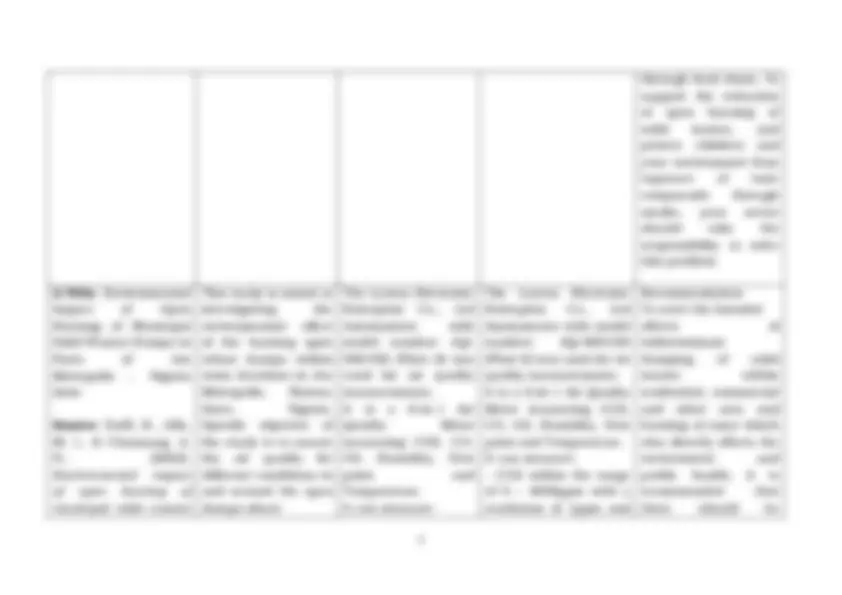
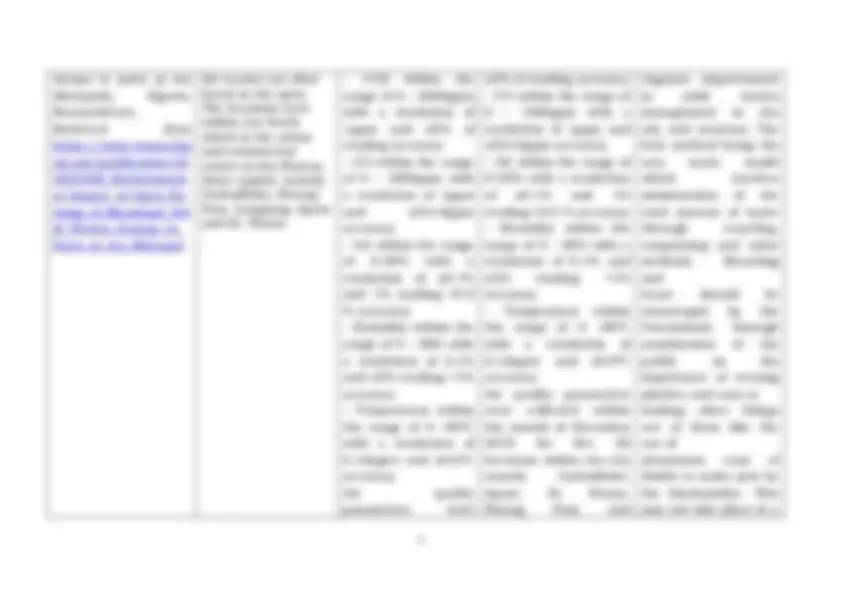

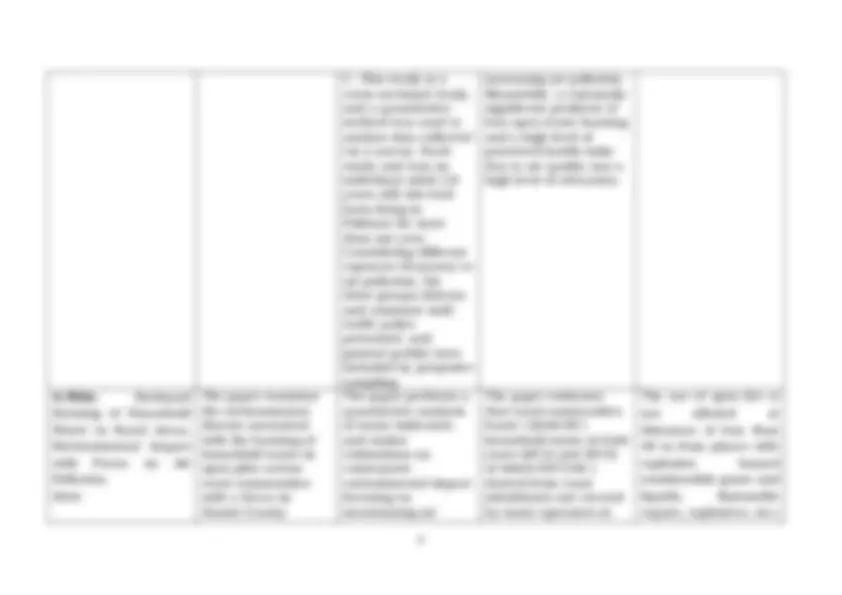
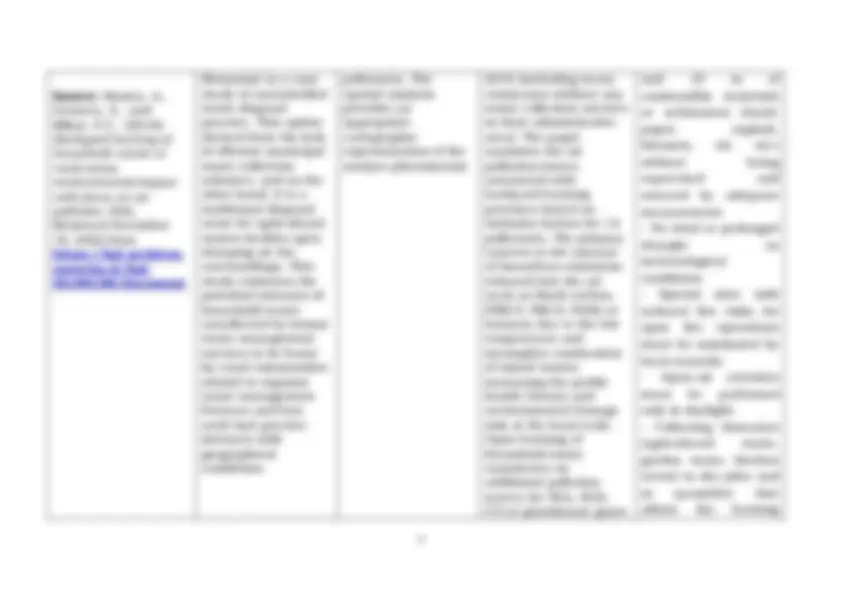
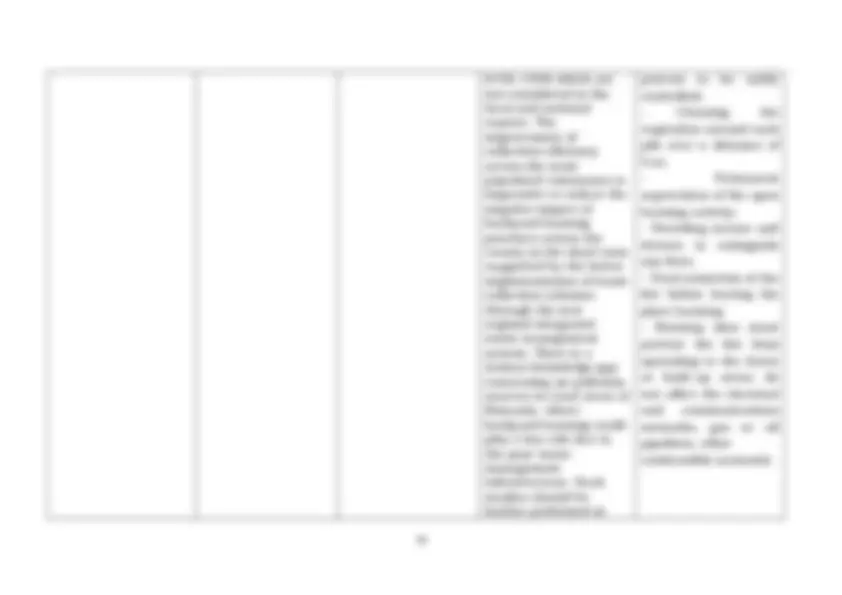
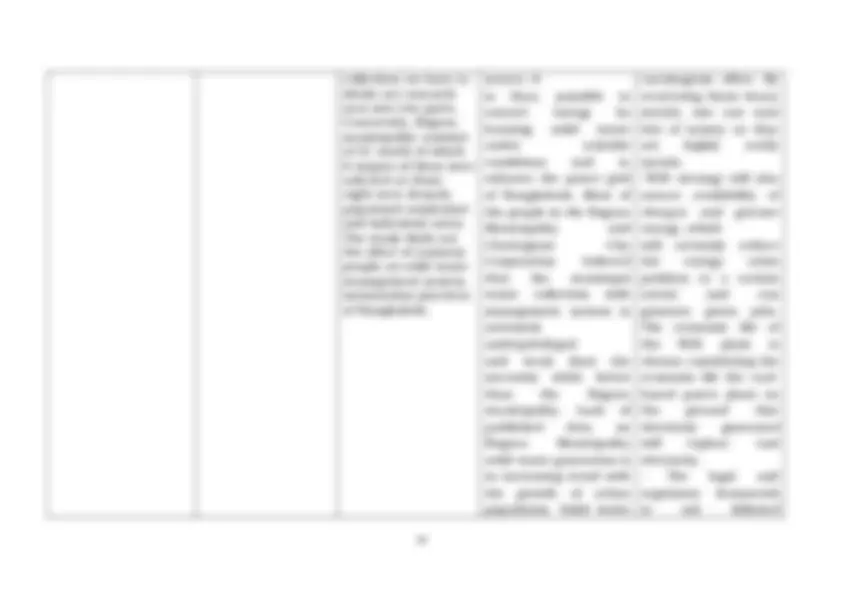
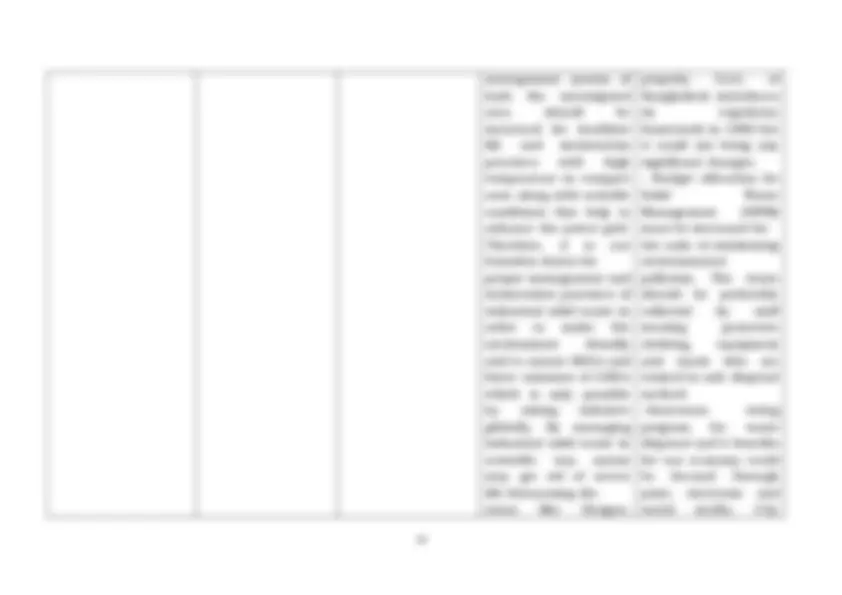
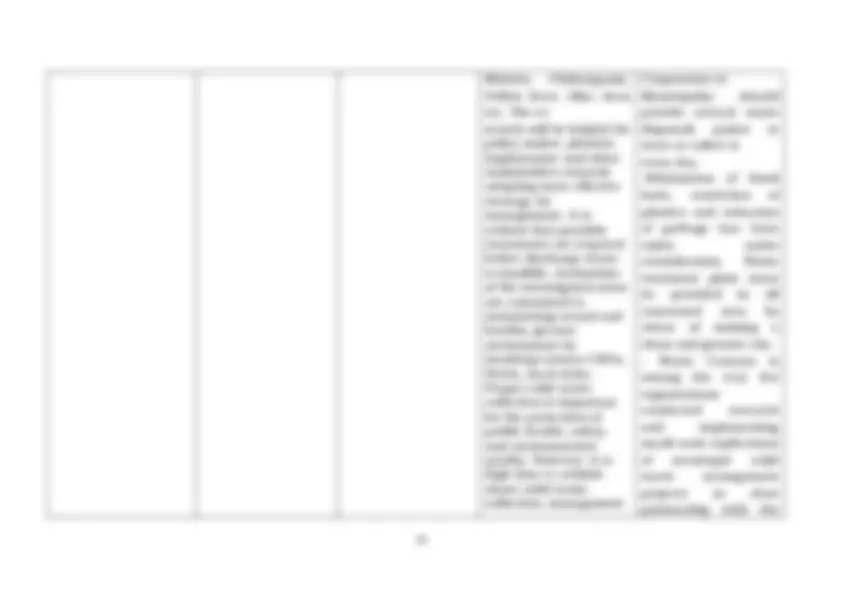
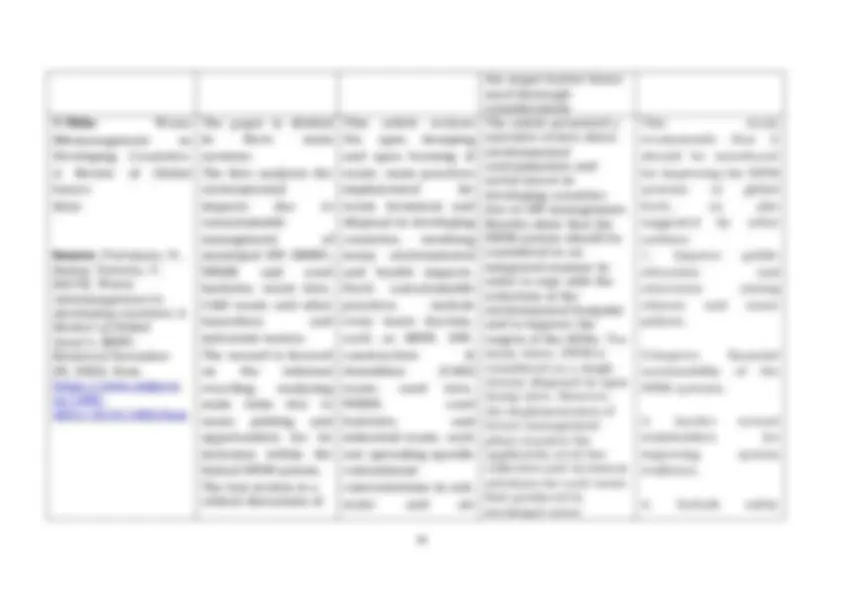

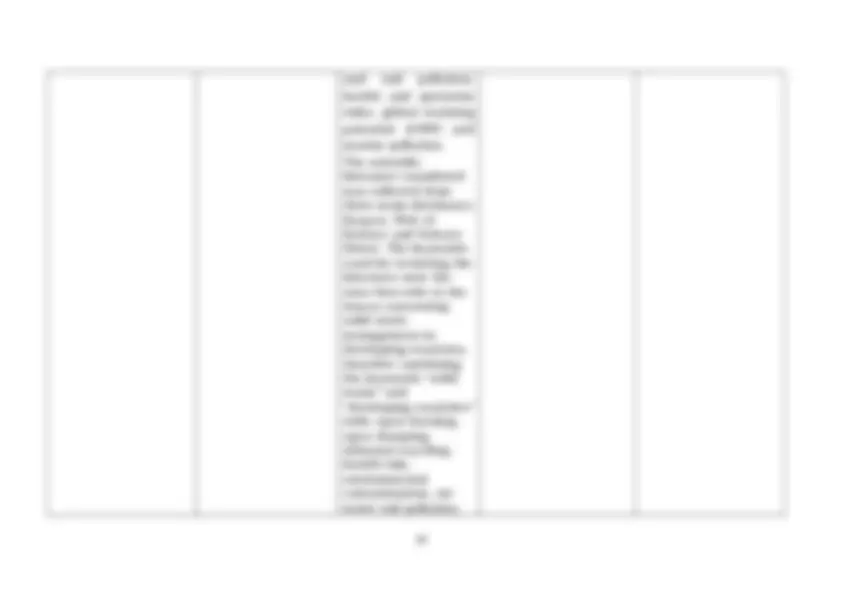

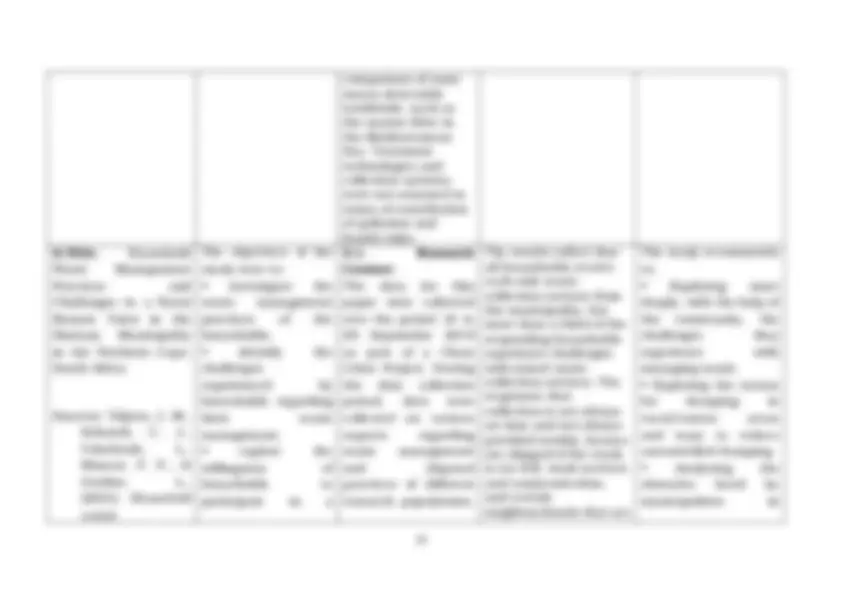
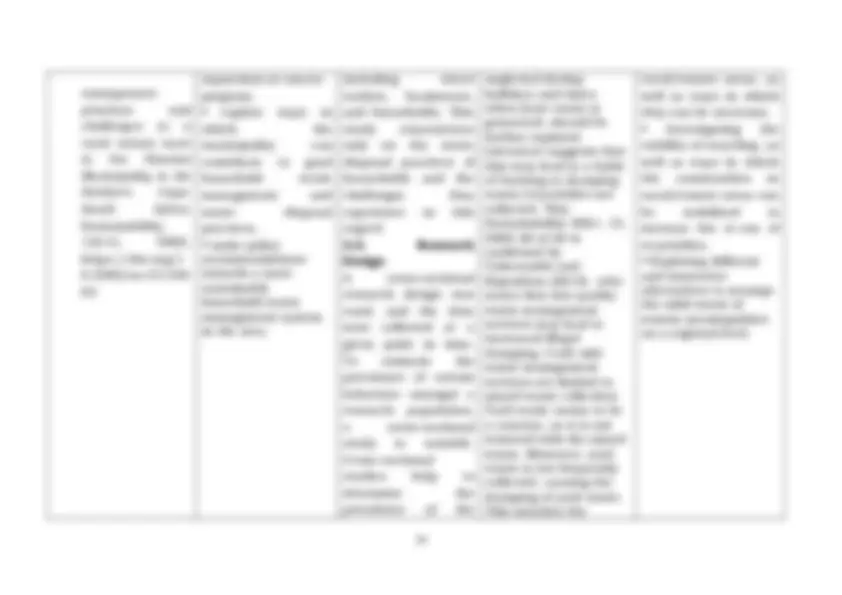


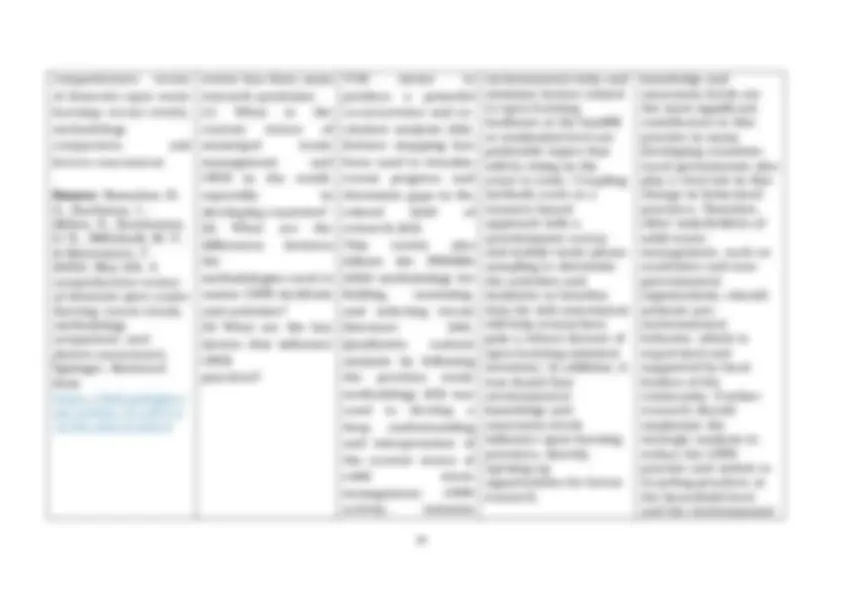
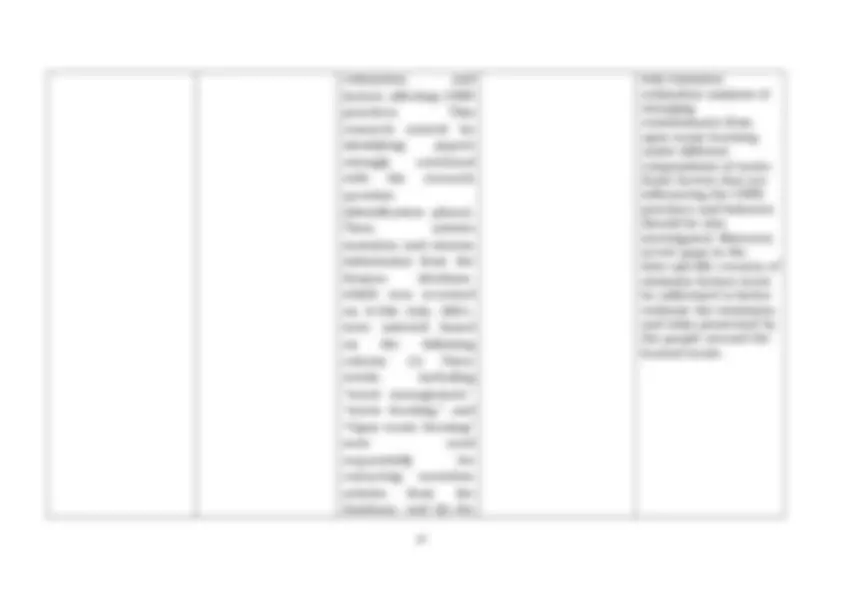
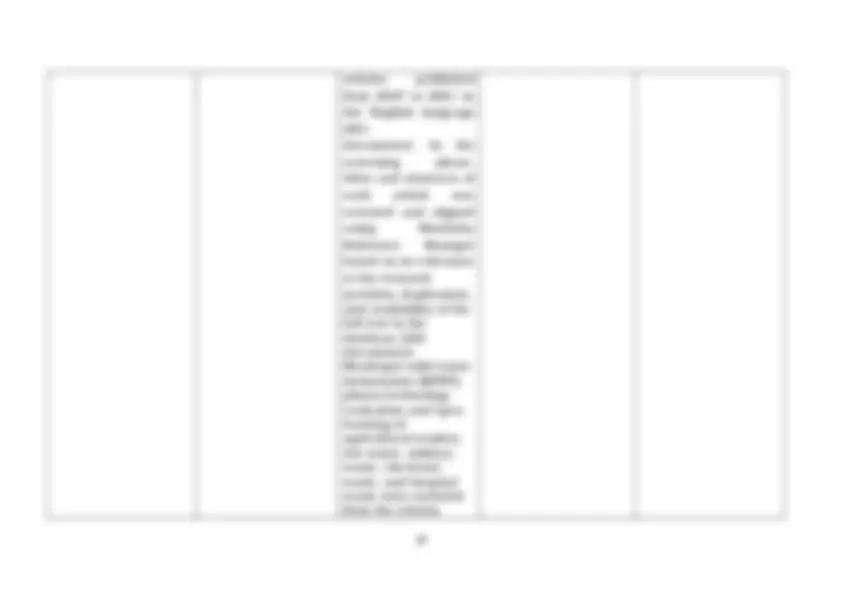
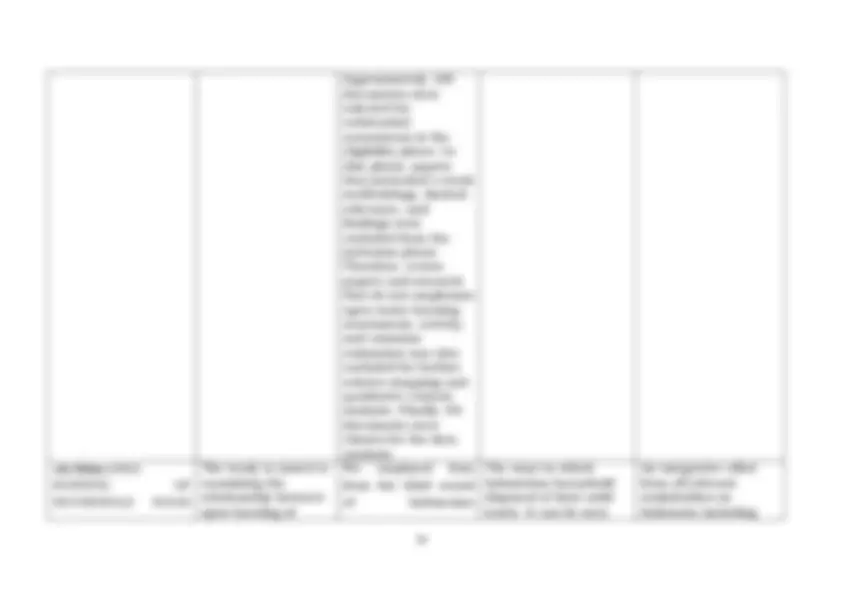
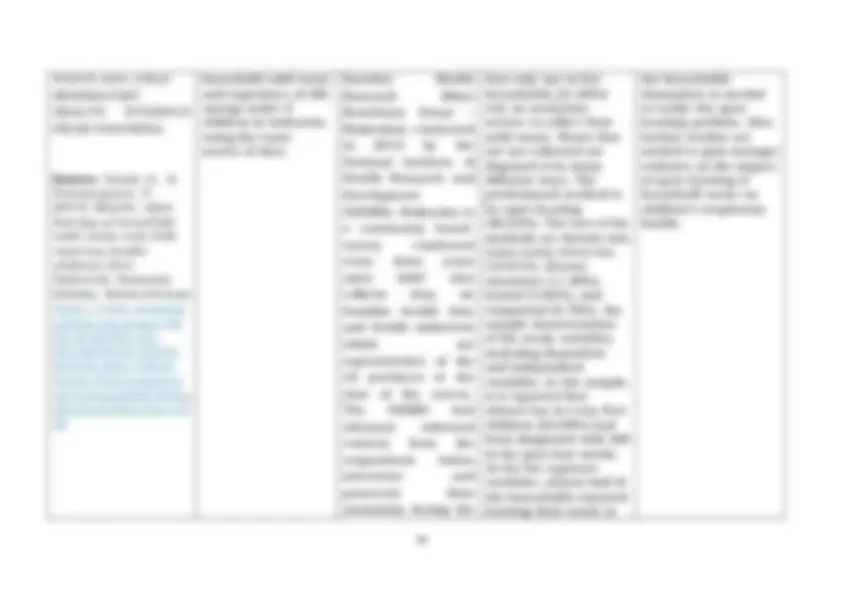









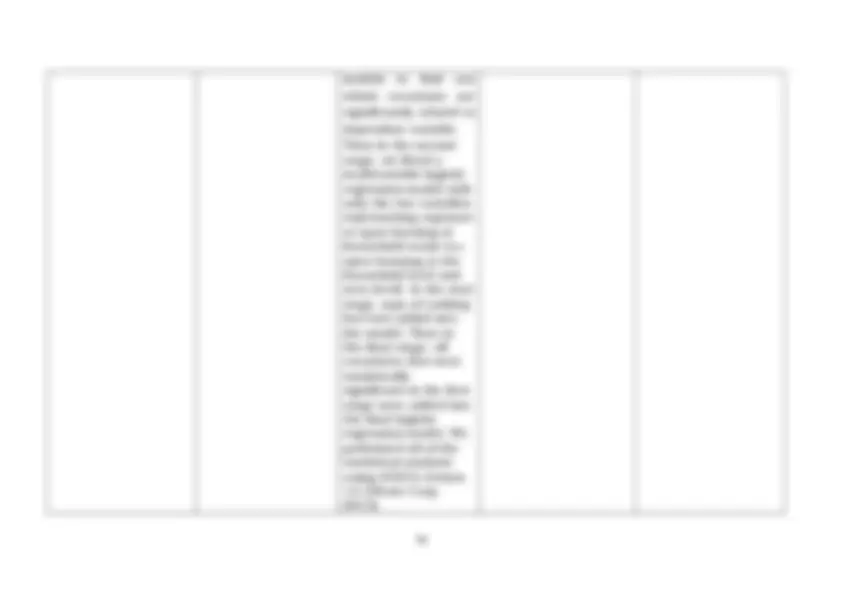
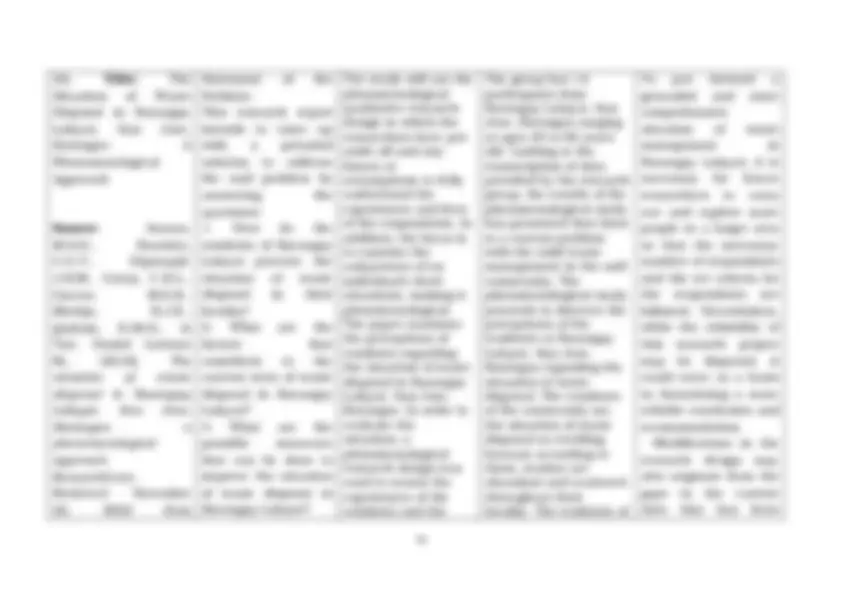
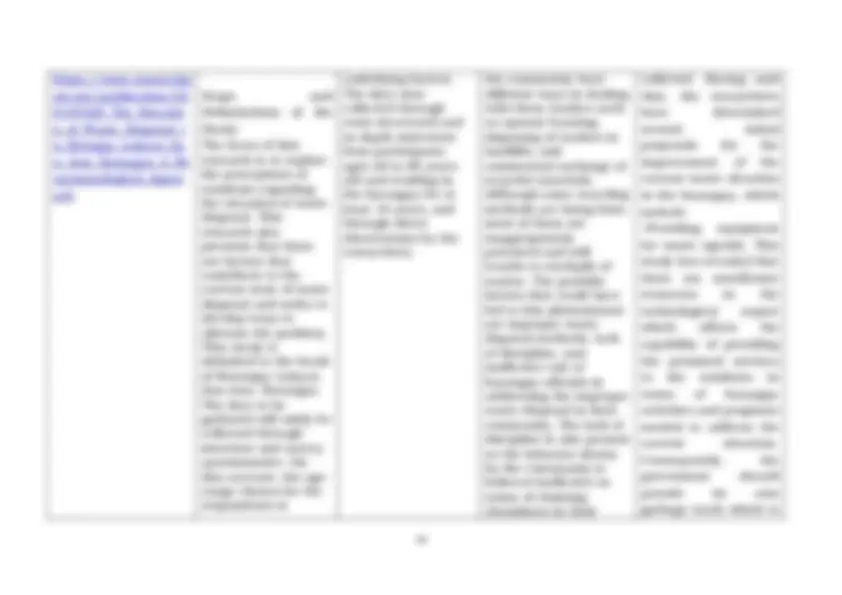
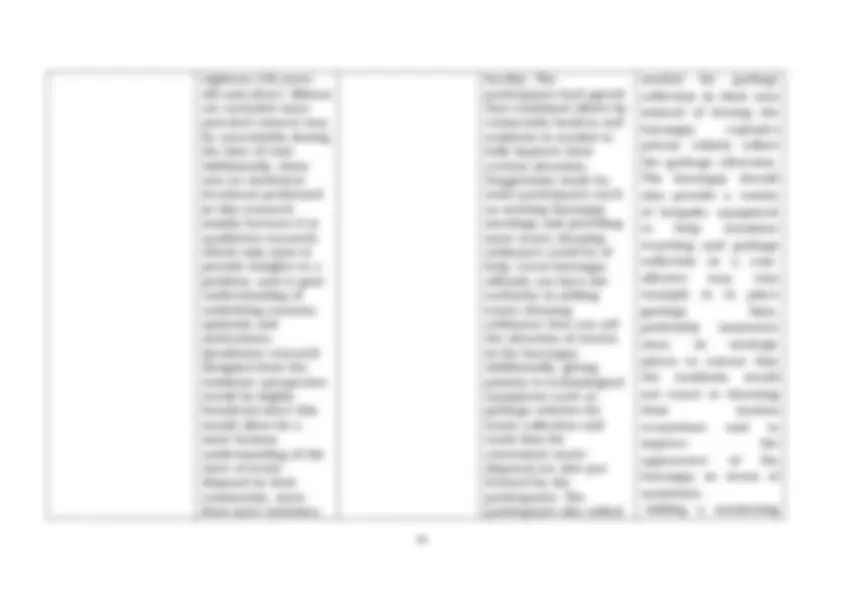
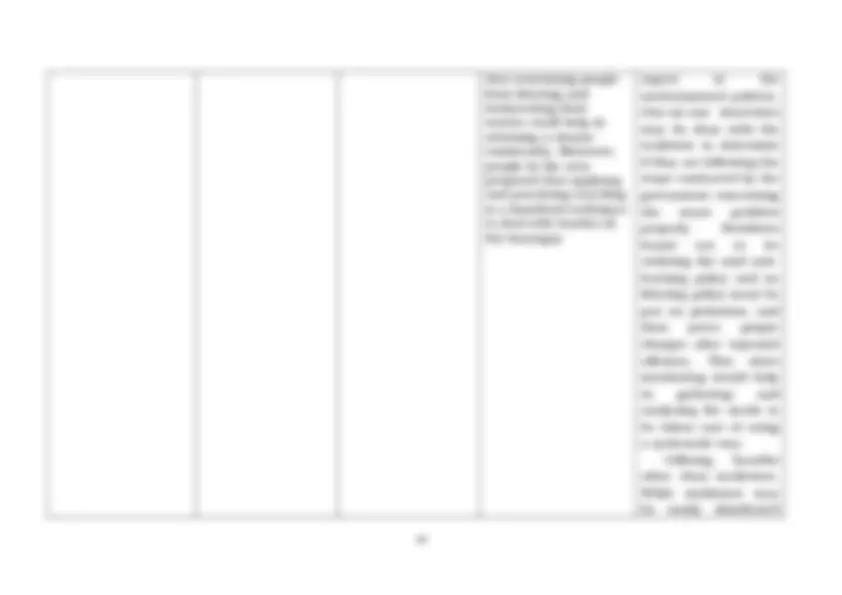



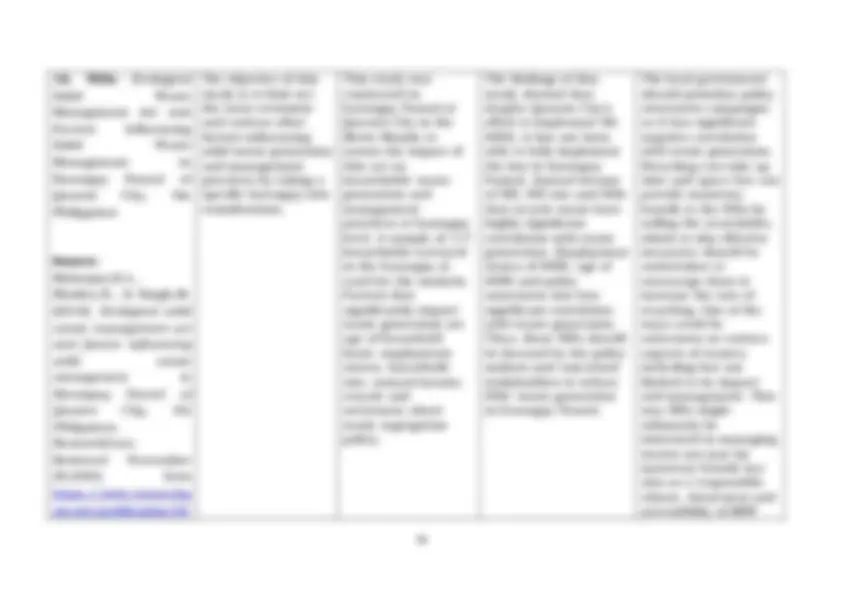

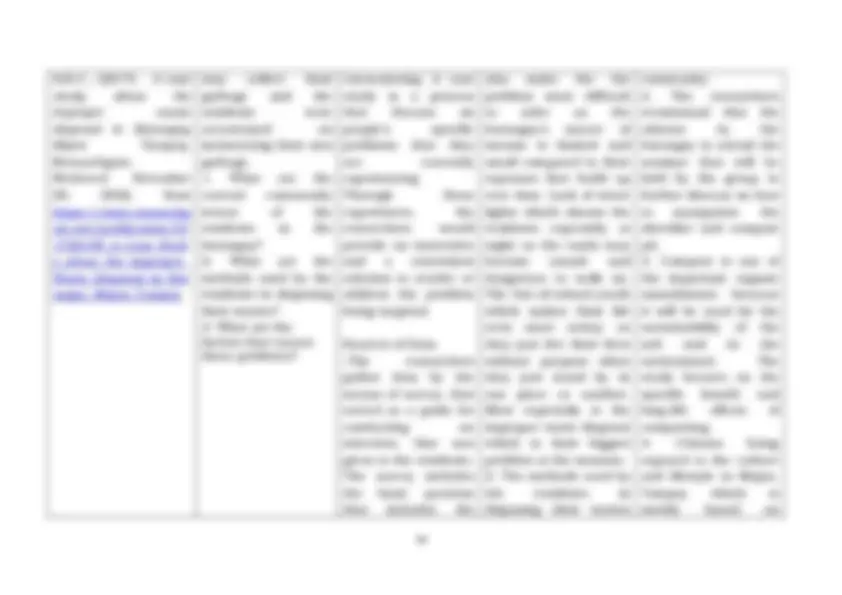
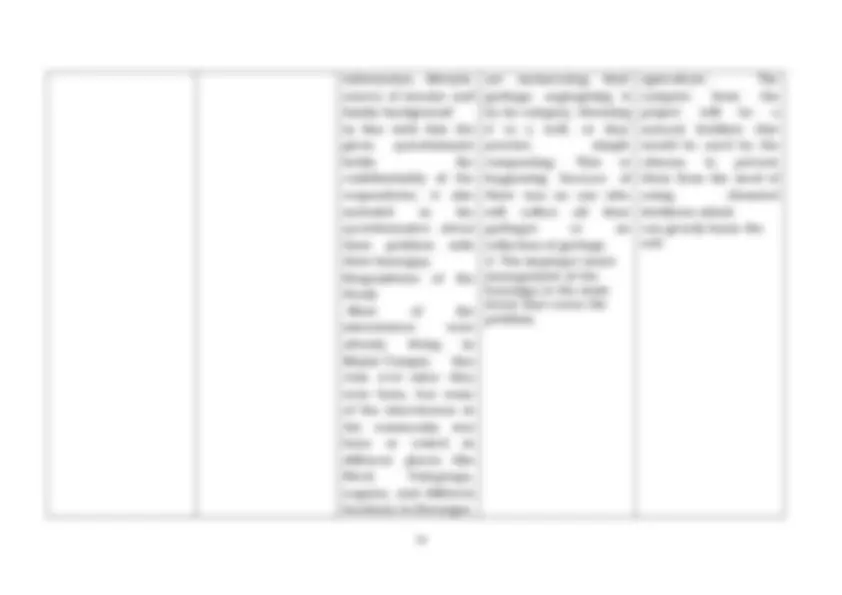
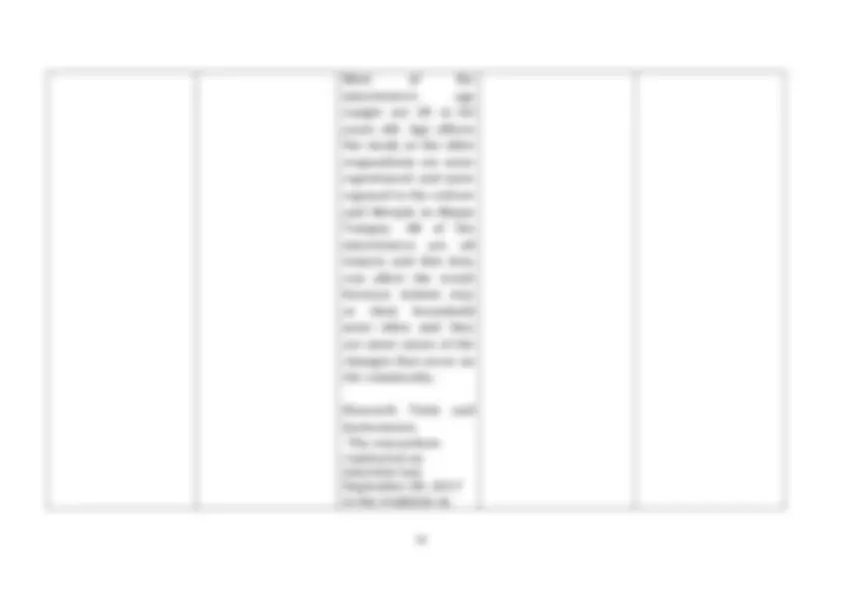


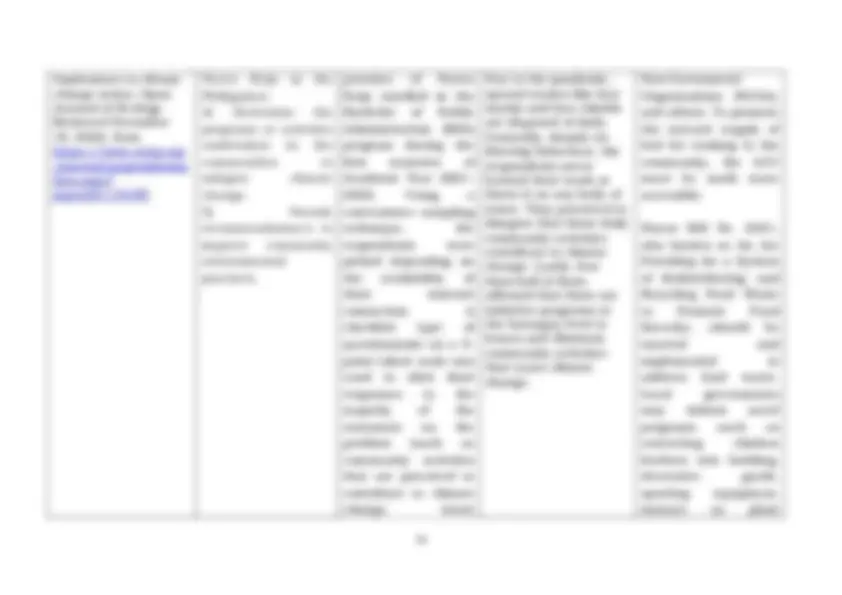
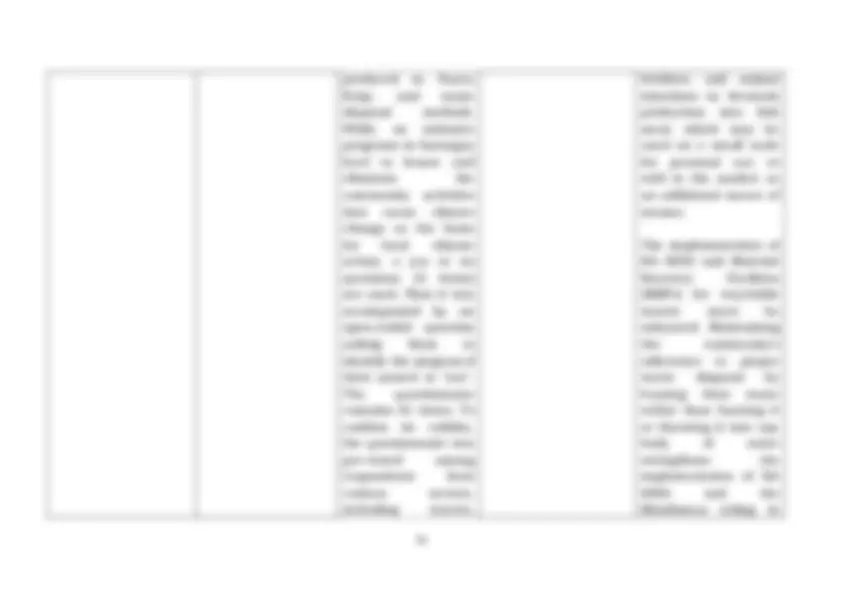
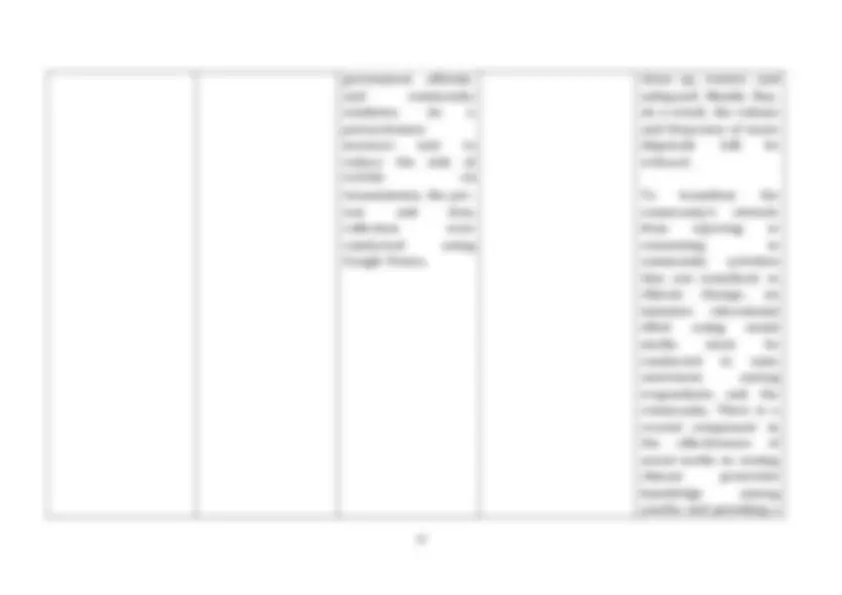



Study with the several resources on Docsity

Earn points by helping other students or get them with a premium plan


Prepare for your exams
Study with the several resources on Docsity

Earn points to download
Earn points by helping other students or get them with a premium plan
Community
Ask the community for help and clear up your study doubts
Discover the best universities in your country according to Docsity users
Free resources
Download our free guides on studying techniques, anxiety management strategies, and thesis advice from Docsity tutors
A review of various studies on the environmental impact of open burning of household waste in developing countries. The studies discussed in this document highlight the need for proper solid waste management and the negative consequences of open burning, including air and water pollution and health risks. The document also suggests that education and awareness campaigns, as well as the implementation of appropriate waste management systems, are necessary to reduce the practice of open burning.
Typology: Cheat Sheet
1 / 58

This page cannot be seen from the preview
Don't miss anything!



















































Research Title and Source Problem/Objectives Methodology Findings/ Result Recommendation
Sample Size The total population and number of household were gathered from statistical agency for each town. Statistical analysis Data were analyzed by combining both qualitative and quantitative sources. Descriptive statistics, mean, tabulation and percentages were used to summarize the data. Analysis of variance (ANOVA) was employed to determine significant differences between concentrations of heavy metals. following recommendations depend on results obtained from assessment, field observation and soil physicochemical analysis. they should coordinate with higher governmental bodies, different NGO and community as well as adopting their rule and regulation to minimize such problem in order to keep the health their residence. For public health and other concerned bodies The safety and health of the children is roadmap for the next generation but their heart is not mature to tolerate the smoke from burning of solid wastes which may affect their wellbeing as well as intelligence. Furthermore, soil is highly vulnerable to such practice which can affect organism
dumps in parts of Jos Metropolis, Nigeria. ResearchGate. Retrieved from https://www.researchg ate.net/publication/ 3451948_Environment al_Impact_of_Open_Bu rning_of_Municipal_Sol id_Wastes_Dumps_in_ Parts_of_Jos_Metropol the wastes are often burnt in the open. The locations were within Jos North which is the urban and commercial centre in the Plateau State capital, namely GadanBako, Rwang Pam, Langtang, Apata and St. Pirans.
collected within the month of December 2019 for five (5) locations within Jos city namely GadanBako, Apata, St. Pirans, Rwang Pam and Langtang Street. The parameters measured were: Oxygen (O2), Carbon monoxide (CO), Carbon dioxide (CO2) and Humidity. Air quality data were collected for the following conditions around the open dump sites: I. Air quality measurement at the dumpsite when it was not burning. II. Air quality measurement at the dumpsite when it was burning. Langtang Street. The parameters measured were: Oxygen (O2), Carbon monoxide (CO), Carbon dioxide (CO2) and Humidity. Air quality data were collected for the following conditions around the open dump sites: I. Air quality measurement at the dumpsite when it was not burning. II. Air quality measurement at the dumpsite when it was burning. III. Air quality measurement 50m away from the burning dumpsite. IV. Air quality measurement 50m away in the opposite direction from the burning short time but must be a deliberate policy of government who will provide the infrastructure required and carry out continuous intensive sensitization of the populace to discard the use and throw away attitude. Considering the effects the open dumpsites have on public health and environment, people should be completely discouraged from setting open dumps within the vicinity of residential or commercial areas. The public should be enlightened on the need of separation of wastes, such as plastics, biodegradable or organic wastes,
3.Title: Open waste burning contrary to other air pollution- related perceptions and practices in Pokhara, Nepal asia Source: Choi, E., Bhandari, T.R., and Shrestha, N., (2021). Open waste burning contrary to other air pollution-related perceptions and practices in Pokhara, Nepal , Archives of Environmental & Occupational Health, DOI: 10.1080/19338244. 21.2004985. Retrieved November 20 2022 from https://doi.org/10. 0/19338244.2021. 4985 This study aims to assess public perceptions and practices regarding air quality and related health risks and to determine whether the perceptions lead to appropriate practice that reduce air pollution from open burning of domestic waste, and whether the sociodemographic conditions influence the practice among residents in Pokhara Metropolitan City, Nepal. The study was conducted in Pokhara Metropolitan City Nepal with an area of 464.24 km2 and a population exceeding 402,000, as of 2016.18 Pokhara is the capital of the Gandaki Province and is located approximately 200 km west of the national capital, Kathmandu. The Annapurna range, home to three out of the ten highest peaks in the world, is within a 24–56 km radius of the Pokhara Valley. The annual mean rainfall in Pokhara in 2017 was 3,743 mm (receiving the highest precipitation in July and the lowest in November, December, or January), and the mean annual temperature is 22. The harmful impacts of open waste burning, unlike other air pollutant emission sources, have been underestimated or undervalued by scientists and policymakers. It is inferred that, because of such underestimation or undervaluation, especially in developing countries, open burning of domestic waste occurs frequently contrary to the perceptions and practices required to reduce air pollution. Unexpectedly, frequent practice of open waste burning was predicted by a high rated contribution of open waste burning to outdoor air pollution, a high level of perceived health risks due to air quality, and frequent refraining from actions The results of this case study suggest that greater attention and assistance are needed to inform people in developing countries of the contribution of open waste burning to air pollution and its associated health risks to change the practice. Additionally, it should be accompanied by an emphasis on the importance of adequate and appropriate services for the collection and disposal of waste to reduce air pollution and its health impacts.
C. This study is a cross-sectional study, and a quantitative method was used to analyze data collected via a survey. Each study unit was an individual adult ( years old) who had been living in Pokhara for more than one year. Considering different exposure frequency to air pollution, the three groups (drivers and assistant staff, traffic police personnel, and general public) were included by purposive sampling. increasing air pollution. Meanwhile, a commonly significant predictor of less open waste burning and a high level of perceived health risks due to air quality was a high level of education. 4.Title: Backyard Burning of Household Waste in Rural Areas. Environmental Impact with Focus on Air Pollution. done The paper examines the environmental threats associated with the burning of household waste in open piles across rural communities with a focus on Neamt County The paper performs a quantitative analysis of waste indicators and makes estimations on consequent environmental impact focusing on inventorying air The paper estimates that rural communities burnt 12244.96 t household waste in both years (2012 and 2015) of which 8273.62 t derived from rural inhabitants not covered by waste operators in The use of open fire is not allowed at distances of less than 40 m from places with explosion hazard (combustible gases and liquids, flammable vapors, explosives, etc.)
(CO2, CH4) which are not considered in the local and national reports. The improvement of collection efficiency across the most populated communes is imperative to reduce the negative impact of backyard burning practices across the county in the short term supported by the better implementation of waste collection schemes through the new regional integrated waste management system. There is a serious knowledge gap concerning air pollution sources in rural areas of Romania, where backyard burning could play a key role due to the poor waste management infrastructure. Such studies should be further performed in process to be safely controlled;
other regions supported by experimental analysis (where possible) to better understand the pollution mechanisms and to adjust the emission factors to regional features. 5.Title: Solid Waste Management and Incineration Practice: A Study of Bangladesh asia Source: Alam, J., and Rahman, M.S., (2020). Solid waste management and incineration practice: a study of Bangladesh. International Journal of Nonferrous Metallurgy, 9, 1-25. https://doi.org/10. 6/ijnm.2020. The objective of the studies is recyclable and reusable solid waste pattern. Furthermore, it has been focused on the present status of solid waste and its respective management as well as incineration practices. It was conducted by using several municipal inorganic wastes and the related factors of this study are different types of solid waste collection, transportation, and storage; and incineration system in The field survey of this study has been performed in Bogura Municipality and Chattogram City Corporation. The dumping sites of Bogura Municipality and Chattogram City Corporation are demonstrated in Figure 3 and Figure 4 respectively. Mixed methods were applied to collect information, analyzing and integrating qualitative and quantitative data. The results showed that the total amount of solid waste produced in Bogura municipality was about 200.88 tons per day and Chattogram City Corporation is 1233.79 tons per day. Besides, it is found that the percentage compositions of solid waste of both the investigated areas are very close to each other irrespective of material contents. The physical components of both the investigated area were shown in irrespective of -A sound and healthy knowledge regarding the solid waste’s characterization be- fore disposal is important for the management of MSW. When planning storage places for hazardous chemical waste, the characteristics of the specific chemicals to be stored and disposed of must be considered (i.e., inflammable, corrosive, ex-plosive).
collection; we have to divide our research area into two parts. Conversely, Bogura municipality consists of 21 wards of which 8 majors of them were selected as those eight were densely populated residential and industrial areas. The study finds out the effect of common people on solid waste management system, incineration practices of Bangladesh. source. It is thus, possible to convert energy by burning solid waste under suitable conditions and to enhance the power grid of Bangladesh. Most of the people in the Bogura Municipality and Chattogram City Corporation believed that the municipal waste collection with management system is extremely underprivileged and weak than the necessity while better than the Bogura municipality. Lack of published data on Bogura Municipality solid waste generation is in increasing trend with the growth of urban population. Solid waste carcinogenic effect. By recovering those heavy metals, one can earn lots of money as they are highly costly metals. -WtE strategy will also ensure availability of cheaper and greener energy, which will certainly reduce the energy crisis problem to a certain extent and can generate green jobs. The economic life of the WtE plant is chosen considering the economic life the coal- based power plant on the ground that electricity generated will replace coal electricity.
management system of both the investigated area should be increased for healthier life and incineration practices with high temperature in compact zone along with suitable conditions that help to enhance the power grid. Therefore, it is our bounden duties for proper management and incineration practices of industrial solid waste in order to make the environment friendly and to ensure SDGs and lower emission of GHGs which is only possible by taking initiative globally. By managing industrial solid waste in scientific way nation may get rid of severe life-threatening dis- eases like Dengue, properly. Govt. of Bangladesh introduces its regulatory framework in 1996 but it could not bring any significant changes.
and incineration practices for the welfare of the nation as well as to protect the world. The results of Focus group discussions (FGD) and Key Informants Interviews (KII) are discussed elsewhere. Government all over the country. Much more research and monitoring should be taken in consideration for productive industrial involvement. -All households will be encouraged to purchase and use compost bins available in the market. As part of the strategy, the City Corporations or Pauroshava will provide market information; negotiate with the suppliers and arrange for higher purchase systems; and also develop appropriate subsidies for the poorer sections to obtain the bins that will be effective for the livelihood for the poorest people of the locality. 6.Title: People’s awareness on effects of To assess people’s knowledge on the This was a cross sectional descriptive Health and environmental There is a need to carry out
open burning of household waste in Kinondoni Municipality, Dar-es- Salaam Source: Israel. P., (2010). People’s awareness on effects of open burning of household waste in Kinondoni Municipality, Dar-es-Salaam. Dar-es- Salaam Medical Students’ Journal. Retrieved November 22, 2022, frorm https://www.ajol.info/i ndex.php/dmsj/article /view/ health and environmental effects associated with open burning of household wastes at Kinondoni Municipality in Dar es Salaam City. study that involved 300 respondents. Structured closed and open-ended questionnaire were used in data collection and the study was carried in between February to May, 2007. Data coding was done during data collection & quantitative data analysis was done through SPSS Version 12, a computer package programme, whereas qualitative data sociological/anthropo logical methods in data analysis were used. awareness of people on effects of open burning practice was high (61.7%). However, out of 300 respondents, 213(71.0%) reported to continue using open burning as their final disposal mechanism due to poor existing infrastructure (76.0%), cost implication (94.8%). Low frequency of waste collection (94.3%) and as normal practice habit (46%). The results from this study showed that people are aware of the health and environmental effects associated with open burning of household wastes. However, the existing infrastructure, low frequency of waste collection and refuse collection fee becomes comprehensive studies that will involve air, water and soil sampling to look on the effects of the practice in the environment. The contents of the emissions should be determined. Community based interventions should be used to incorporate and involve people in discouraging this practice. Various waste disposal mechanisms including recycling should be designed to suit for the existing infrastructure of different areas. Health education on waste management is needed focusing on waste sorting at the source in order to separate different types of waste so that different types of wastes should be treated separately.
current and future challenges for improving environmental quality at global level, identifying the opportunities due to SWM selective collection and treatment systems. environments. Waste pickers work within these sites for collecting recyclable materials that are sold in local markets. Though this informal practice allows decreasing the amounts of waste inflow into water bodies and open dumps, it is also a hazardous activity that improves health and occupational risks. Therefore, concerning waste open burning and open dumping, the narrative review presented in this article explores environmental impacts due to unsustainable SWM, such as water, air MSW(organic and inorganic),HW, C&D waste, WEEE and used batteries, industrial and hazardous waste and used tires. precautions in the informal recycling sector,
and soil pollution, health and operation risks, global warming potential (GWP) and marine pollution. The scientific literature considered was collected from three main databases: Scopus, Web of Science and Science Direct. The keywords used for reviewing the literature were the ones that refer to the issues concerning solid waste management in developing countries, therefore combining the keywords “solid waste” and “developing countries” with: open burning, open dumping, informal recycling, health risk, environmental contamination, air- water-soil pollution,